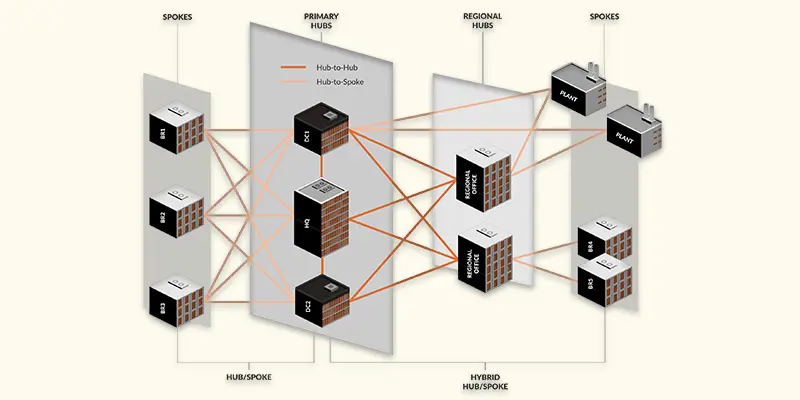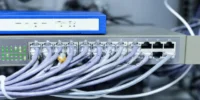How SD-WAN Topology Transforms Business Networks
Published: 28 Apr 2025
SD WAN Topology
In contemporary networking, SD-WAN topology is essential since it allows companies to maximise security and connection across several sites. Yet, many struggle to choose the right topology: should you go with hub-and-spoke, full mesh, or a cloud-enabled approach? Without the right setup, companies face slow connections, security risks, and high costs. Imagine a network that adapts in real-time, prioritizing critical applications while cutting expenses. That’s the power of SD-WAN topology.
Understanding SD-WAN Topology
SD-WAN topology is the way networks are structured to connect different locations. It decides how data moves between offices, data centers, and the cloud. The right topology improves speed, security, and reliability.
Different SD-WAN topologies exist, like hub-and-spoke, full mesh, and cloud-enabled setups. Each has its benefits depending on business needs. Choosing the right one helps improve performance and lower costs.

Define Network Topology and its Role in SD-WAN
Network topology is the layout of how devices and connections are arranged in a network. It outlines the data flow between several locations, including cloud services, data centres, and offices.
In SD-WAN, topology plays a key role in managing traffic efficiently. It helps improve performance, security, and reliability by choosing the best path for data to travel. The right topology ensures smooth communication and reduces network downtime.
Common SD-WAN topologies are different ways to set up a network to connect multiple locations efficiently.
- Cloud-Enabled SD-WAN
- Partial Mesh Topology
- Hub-and-Spoke Topology
- Hybrid Topology
- Full Mesh Topology
Hub-and-Spoke Topology
Branch sites are connected to a central hub, such as headquarters or a data centre, via a hub-and-spoke structure. This setup makes management easier and improves security, but can slow down traffic.
Example: A company with multiple branch offices connects all locations to its main headquarters for data storage and security.
| Benefits of Hub-and-Spoke Topology |
|---|
|
Full Mesh Topology
A full mesh topology connects all locations directly to each other, ensuring fast communication and no single point of failure. This setup improves performance but can be costly and complex.
Example: A global company with offices in different countries connects all locations directly for real-time collaboration and data sharing.
| Benefits of Full Mesh Topology |
|---|
|

Partial Mesh Topology
Some places are directly connected via partial mesh topology, while others are connected by a central hub. By lowering the number of direct links, it strikes a compromise between cost and efficiency. This setup is more flexible than hub-and-spoke but less expensive than full mesh.
Example: A retail chain connects major stores directly, while smaller branches communicate through a regional hub.
| Benefits of Partial Mesh Topology |
|---|
|
Cloud-Enabled SD-WAN
Cloud-enabled SD-WAN connects business locations directly to cloud services like AWS, Azure, or Google Cloud. This setup improves application performance, reduces latency, and enhances security.
Example: A company using Office 365 and video conferencing connects branches directly to the cloud for faster access and smoother performance.
| Benefits of Cloud-Enabled SD-WAN |
|---|
|
Hybrid Topology
Combining two or more network topologies, such as mesh and star, to maximise their respective advantages is known as a hybrid topology. It offers flexibility, better performance, and reliability.
Example: A company uses a star topology for office connections and a mesh topology for data centers to ensure strong backup and high-speed access.
| Benefits of Hybrid Topology |
|---|
|

How to Choose the Right SD-WAN Topology
- Assess Business Needs: Identify network size, locations, and data flow requirements.
- Consider Performance: Choose a topology that ensures speed and reliability.
- Evaluate Security: Ensure data protection with encryption and secure gateways.
- Compare Costs: Balance between setup expenses and long-term savings.
- Scalability: Pick a topology that allows easy network expansion.
- Cloud Integration: If using cloud services, consider a cloud-enabled SD-WAN.
- Redundancy Needs: Ensure backup connections for continuous network uptime.
- IT Management: Select a topology that aligns with your team’s expertise and resources.
Conclusion About SD WAN Topology Diagram
SD-WAN topology is a game-changer for businesses looking to improve network performance and security. Based on my experience, I highly recommend choosing a solution that offers centralized management and strong encryption for better control and safety. If you want a faster, more reliable network, start exploring SD-WAN options today.
FAQS
Yes, mesh topology can be used in a WAN. It provides high reliability by connecting multiple nodes, but it is costly and complex.
The best topology depends on the use case. Mesh is great for reliability, Star is easy to manage, and SD-WAN is best for modern networking needs.
SD-WAN topology is a network structure that uses software to manage and optimize WAN connections for better performance, security, and cost savings.
Mesh topology is the most expensive because it requires multiple connections between devices, increasing hardware and maintenance costs.
For high dependability and fault tolerance, a mesh network is utilised. Data can still move across other channels in the event that one connection fails.
SD-WAN and star topology are best for scalability since they allow easy network expansion without high costs or complexity.
WiFi mostly uses a star topology, where all devices connect to a central router or access point. This setup is simple and common in homes and offices.
Yes, you can combine different topologies to create a hybrid network. This helps balance cost, performance, and reliability.

- Be Respectful
- Stay Relevant
- Stay Positive
- True Feedback
- Encourage Discussion
- Avoid Spamming
- No Fake News
- Don't Copy-Paste
- No Personal Attacks

- Be Respectful
- Stay Relevant
- Stay Positive
- True Feedback
- Encourage Discussion
- Avoid Spamming
- No Fake News
- Don't Copy-Paste
- No Personal Attacks





